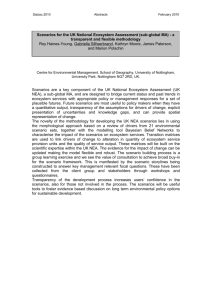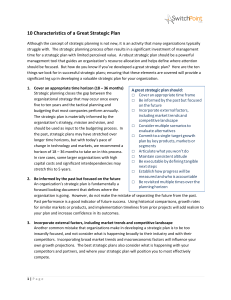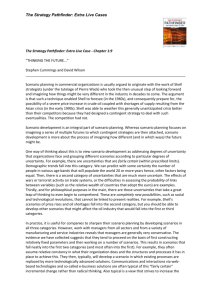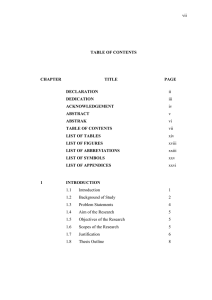Scenario-Based Analysis of Software Architecture
advertisement
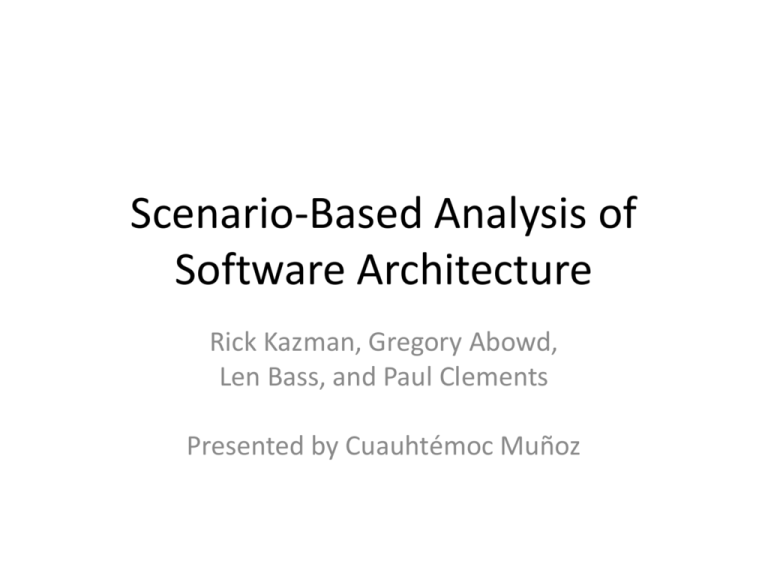
Scenario-Based Analysis of Software Architecture Rick Kazman, Gregory Abowd, Len Bass, and Paul Clements Presented by Cuauhtémoc Muñoz Outline • Software Architecture Analysis Method Overview • Software Architecture Analysis Method Activities • WRCS: Case Study • Advantages of SAAM • Conclusion SAAM Overview • Software Architecture Analysis Method (SAAM) – Scenarios – Quality attributes • Why Scenarios? – Quality attributes and roles SAAM Activities • • • • • • Describe the candidate architecture Develop Scenarios Evaluate each scenario Reveal scenario interactions Weight scenarios and scenarios interactions * Dependencies SAAM WRCS: Case Study (1/11) • WRCS – Version control/configuration management system. – Functions: create projects, compare files, check files in and out, create releases, back up to old versions, etc. WRCS Case Study (2/11) • Applying SAAM: 1. Describe candidate architecture: – Reverse engineering. – Level of abstraction above source code. – Architectural description done iteratively. Three iterations in this case. WRCS Case Study (3/11) WRCS Case Study (4/11) 2. Develop scenarios – Stakeholder representations (e.g. customer). – For the user role: • • • • Compare binary file representations. Compare binary files generated by other products. Configure the toolbar. Manage multiple projects – For the maintainer role: • Port to another operating system. • Modify the user interface in minor ways. WRCS Case Study (5/11) – For the administrator role: • Change access permissions for a project. • Integrate WRCS functionality with a new development environment. • Port to a different network-management system. WRCS Case Study (6/11) 3. Evaluate each scenario – Direct and indirect scenarios • Focus on indirect scenarios. – Estimate the cost of indirect scenarios • Minimal cost (e.g. modifications to a resource file). • Moderate cost (e.g. recompilation). • Considerable cost (e.g. restructuration of code). WRCS Case Study (7/11) WRCS Case Study (8/11) • 4. Reveal scenario interactions – Focus on scenarios with the most interactions. WRCS Case Study (9/11) WRCS Case Study (10/11) 5. Weight scenarios and scenario interactions – Prioritize scenarios based on organizational requirements and preferences of the SAAM user. WRCS Case Study (11/11) • Results: – Severe limitations in achieving portability and modifiability. – SAAM exposed specific product’s limitations in a simple, straightforward, and cost effective way. Advantages of SAAM (1/3) • Enhanced communication – Scenarios. – Visualizations • Improvement of traditional metrics – Coupling and cohesion • Low coupling, high cohesion. • Proper description level – Higher level of abstraction Advantages of SAAM (2/3) – Mapping of scenarios onto the structure • Highlight components and connections that will be affected by the change the scenario implies. • Architectural evaluation. • Validation of scenario interaction. • Appropriate level of architectural representation. – Example: • A case in which multiple indirect scenarios affect a single module. Three possibilities: Advantages of SAAM (3/3) • The scenarios are of the same class. • The scenarios are of different classes and you can further divide the module. • The scenarios are of different classes and you cannot further divide the module. • Efficient scenario generation – Like software testing. Conclusion • SAAM has been applied to large-scale industrial systems such as “Global Information System” and “Air Traffic Control System.” • Future plans include the extension of this technique from maintainability and modifiability to execution-based measures such as performance and reliability.




